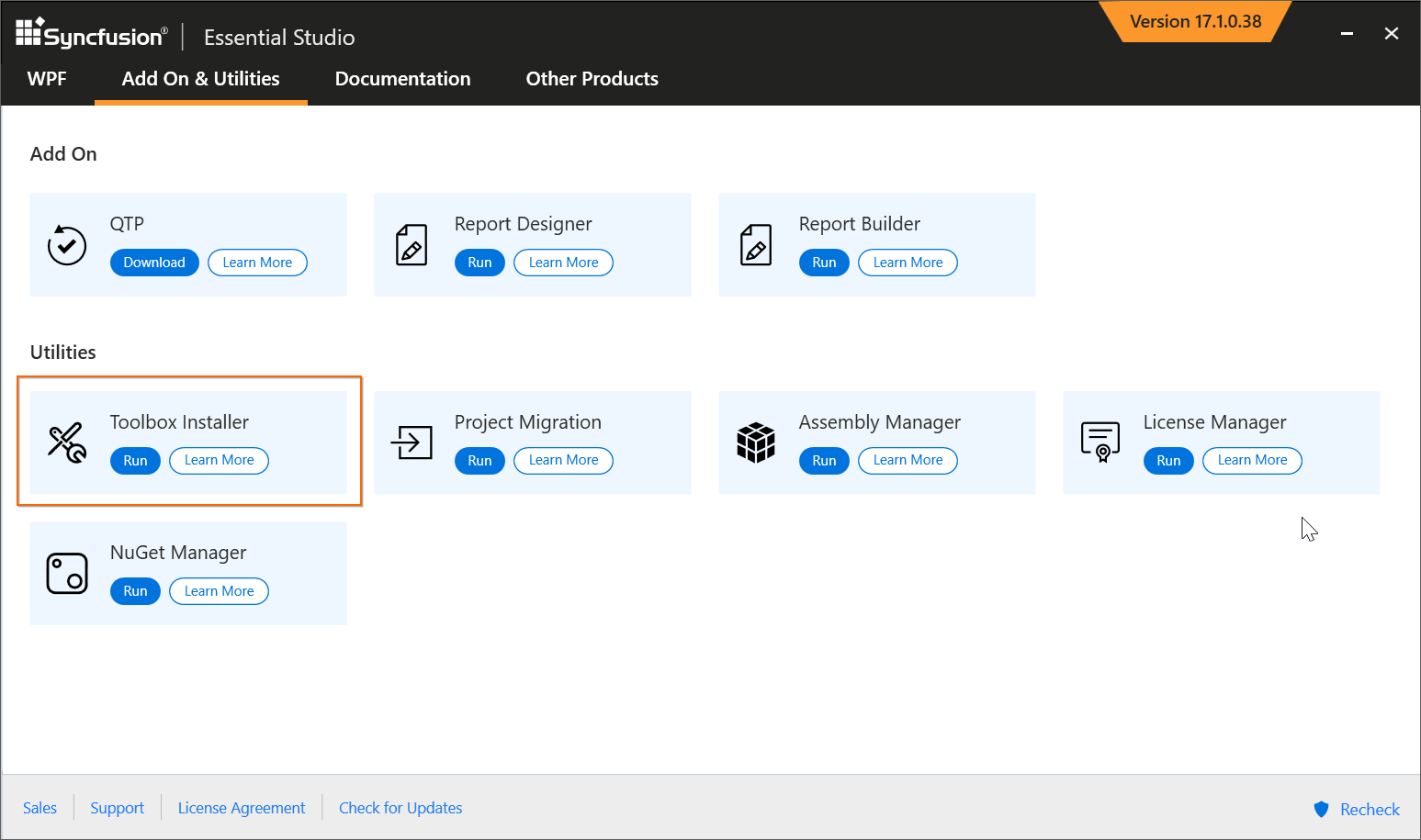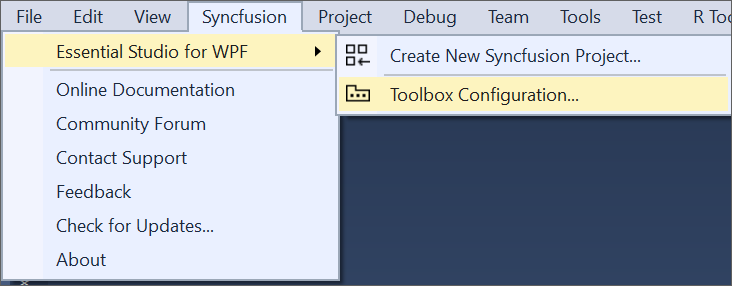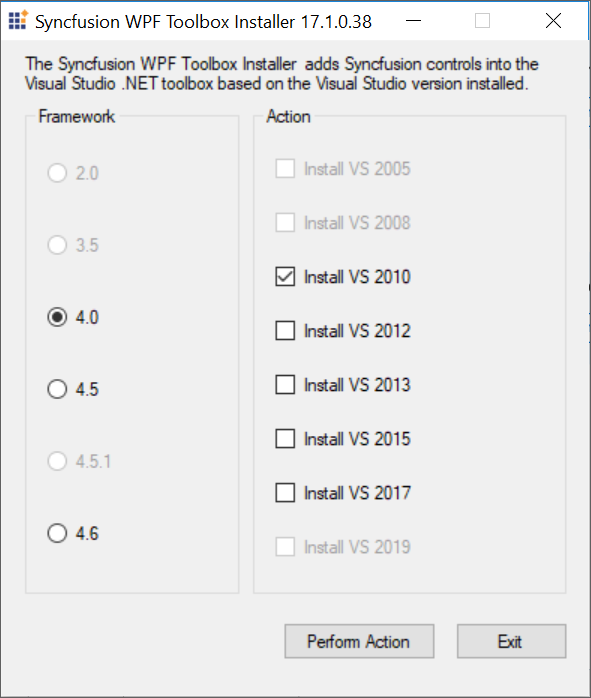Toolbox Configuration
7 Nov 20255 minutes to read
The Syncfusion® Toolbox Installer utility incorporates the Syncfusion® WPF components into the Visual Studio .NET toolbox.
NOTE
Toolbox configuration support is not available for the Visual Studio Express Edition. However, you can manually configure the Syncfusion® controls into the Visual Studio Express Toolbox. To do so, refer the Manual Toolbox Configuration.
If the “Configure Syncfusion® Controls in Visual Studio” checkbox is selected from the installer UI while installing the Syncfusion® WPF installer, Syncfusion® components will be automatically configured in the Visual Studio toolbox.
To add the Syncfusion® WPF components via the Syncfusion® Toolbox Installer, perform the following steps:
-
To launch Toolbox configuration utility, follow either one of the options below:
Option 1:
Open the Syncfusion® Control Panel, click Add On and Utilities > Toolbox Installer.
Option 2:
Click Syncfusion® menu and choose Essential Studio® for WPF > Toolbox Configuration… in Visual Studio
NOTE
From Visual Studio 2019, Syncfusion® menu is available under Extensions in Visual Studio menu.

-
Toolbox Installer will be opened.

The following options are available in Toolbox Configuration:
- Install VS2005 – Configures Framework 2.0 Syncfusion® controls in VS 2005 toolbox.
- Install VS2008 – Configures Framework 3.5 Syncfusion® controls in VS 2008 toolbox.
- Install VS2010 – Configures Framework 4.0 Syncfusion® controls in VS 2010 toolbox.
- Install VS2012 – Configures Framework 4.5 Syncfusion® controls in VS 2012 toolbox.
- Install VS2013 – Configures Framework 4.5.1 Syncfusion® controls in VS 2013 toolbox.
- Install VS2015 – Configures Framework 4.6 Syncfusion® controls in VS 2015 toolbox.
- Install VS2017 – Configures Framework 4.6 Syncfusion® controls in VS 2017 toolbox.
- Install VS2019 – Configures Framework 4.6 Syncfusion® controls in VS 2019 toolbox
- Install VS2022 – Configures Framework 4.6 Syncfusion® controls in VS 2022 toolbox.
- Install VS2026 – Configures Framework 4.6.2 Syncfusion® controls in VS 2026 toolbox.
NOTE
You can also configure Syncfusion® controls from a lower version Framework assembly to higher version of Visual Studio.
-
The successful configuration of Toolbox is indicated by an Information message. Click OK.

NOTE
- You must reset the toolbox, when the installed controls are not reflected properly in the Toolbox.
- This tool configures only the controls that are located under {Installed Location}\Assemblies{Framework version}.
Configuring toolbox for WPF .NET 5.0 projects
From 2021 Volume 1,Syncfusion® started providing toolbox support for the WPF .NET 5.0 framework in Visual Studio. After installing the Syncfusion® WPF installer, Syncfusion® controls will be automatically configured in the Visual Studio toolbox for WPF.NET 5.0 projects.
NOTE
- Syncfusion® included this toolbox support for .NET 5.0 WPF platform from 2021 Volume 1 release version v19.1.0.54 only.
- If the project was created with TargetFramework.NET Core 3.1 and then changed to.NET 5.0 after installing the WPF setup, you must restart Visual Studio to see the Syncfusion® controls in the Visual Studio Toolbox.
- Visual Studio 2019 16.7 Preview 2 and later is required.
Upgrading the Syncfusion® WPF toolbox .NET 5.0 controls without installing the build
You can upgrade the Syncfusion® WPF toolbox for .NET 5.0 control with NuGet packages downloaded from nuget.org. Download “Syncfusion.UI.WPF.NET” package from nuget.org in your machine.
Use the following steps to add the Syncfusion® WPF controls through Syncfusion® NuGet packages:
step 1:
Extract “Syncfusion®.UI.WPF.NET” package by using the below commands.
Open Command prompt from nuget.exe path and run the following commands
Command: {nuget.exe path} add “F:\Syncfusion\Syncfusion.UI.WPF.NET.{version}.nupkg” -Source “F:\Syncfusion\Expand” -expand
Example: F:\Syncfusion>nuget.exe add “F:\Syncfusion\Syncfusion.UI.WPF.NET.19.1.0.50.nupkg” -Source “F:\Syncfusion” -expand

step 2:
Open “Syncfusion® Toolbox for WPF.config” file from the following location.
Location: “C:\Program Files (x86)\NuGet\Config\Syncfusion Toolbox for WPF.config”

Or you can create this file in the same location by using the XML format given below
<?xml version="1.0" encoding="utf-8"?>
<configuration>
<fallbackPackageFolders>
<add key="Syncfusion<sup style="font-size:70%">®</sup> Toolbox Local NuGet Packages {version}" value="F:\Syncfusion" />
</fallbackPackageFolders>
</configuration>step 3:
Update extracted Syncfusion® NuGet package path in value attribute.
Example:

step 4:
Now restart the Visual Studio 2019 to get populate the latest Syncfusion® controls in Toolbox.
Configuring toolbox for .NET Core 3.1 projects
The Syncfusion® NuGet packages must be installed in the WPF .NET Core application before the Syncfusion® toolbox can be configured. The corresponding NuGet packages Syncfusion® components will be configured in Visual Studio toolbox after installing the Syncfusion® NuGet packages in.NET Core application.
Please refer the documentation link, to learn more about how to use the Syncfusion® components using the Syncfusion® NuGet packages in .NET Core application.